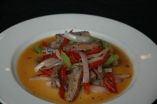(Press-News.org) HOUSTON -- (Sept. 15, 2010) -- In a new study this week, Rice University scientists bring the latest tools of computational biology to bear in examining how the processes of natural selection and evolution influence the way bacteria acquire immunity from disease.
The study is available online from Physical Review Letters. It builds upon one of the major discoveries made possible by molecular genetics in the past decade -- the revelation that bacteria and similar single-celled organisms have an acquired immune system.
"From a purely scientific perspective, this research is teaching us things we couldn't have imagined just a few years ago, but there's an applied interest in this work as well," said Michael Deem, the John W. Cox Professor in Biochemical and Genetic Engineering and professor of physics and astronomy at Rice. "It is believed, for instance, that the bacterial immune system uses a process akin to RNA interference to silence the disease genes it recognizes, and biotechnology companies may find it useful to develop this as a tool for silencing particular genes."
The new study by Deem and graduate student Jiankui He focused on a portion of the bacterial genome called the "CRISPR," which stands for "clustered regularly interspaced short palindromic repeats." The CRISPR contain two types of DNA sequences. One type -- short, repeating patterns that first attracted scientific interest -- is what led to the CRISPR name. But scientists more recently learned that the second type -- originally thought of as DNA "spacers" between the repeats -- is what the organism uses to recognize disease.
"Bacteria get attacked by viruses called phages, and the CRISPR contain genetic sequences from phages," Deem said. "The CRISPR system is both inheritable and programmable, meaning that some sequences may be there when the organism is first created, and new ones may also be added when new phages attack the organism during its life cycle."
The repeating sequences appear to be a kind of bookend or flag that the organism uses to determine where a snippet from a phage begins and ends. The CRISPR will often have between 30 and 50 of these snippets of phage sequences. Previous studies have found that once a bacteria has a phage sequence in its CRISPR, it has the ability to degrade any DNA or RNA that match that sequence -- meaning it can fend off attacks from any phages that have genes matching those in its CRISPR.
"What we wanted to explore was how the history of a bacterium's exposure to phages influences what's in the CRISPR," Deem said. "In other words, how is an organism's previous exposure to viruses reflected in its own genome?"
From earlier published studies, Deem and He knew that phage sequences were added to the CRISPR sequentially. So, in a CRISPR system containing 30 snippets, the newest one would be in position one, at the front of the line. In another study in 2007, researchers examining the CRISPR of whole populations of bacteria noticed some statistical irregularities. They found that the likelihood of two different organisms having the same snippet in their CRISPR increased exponentially as they progressed away from position one. So, in the organism with 30 snippets, the phage gene in position 30 was the most likely to be conserved time and again across all the bacteria in the population.
To use the power of computers to examine why this happens, Deem and He needed a mathematical description of what was happening over time to both the bacterial and phage populations. The equations they created reflect the way the bacterial and phage populations interact via the CRISPR.
"Each population is trying to expand, and selective pressure is constantly being applied on both sides," Deem said. "You can see how this plays out in the CRISPR over time. There's a diverse assortment of genes in the first spacer, but the second spacer has been in there longer, so there's been more selective pressure applied to that spacer. Because bacteria that contain the dominant viral strain in their CRISPR are more likely to survive than those that don't, they tend to squeeze out their neighbors that are more vulnerable. At position N, the farthest way from position one, selection has been at work the longest, so the genes we find there were the most common and the ones that tended to afford the most overall protection to the organism."
In addition to interest from biotechnology firms, Deem said the workings of the CRISPR are of interest to drugmakers who are investigating new types of antibiotics.
###
The research was supported by the Defense Advanced Research Projects Agency.
END
Recent puzzling observations of tiny variations in nuclear decay rates have led some to question the science of using decay rates to determine the relative ages of rocks and organic materials. Scientists from the National Institute of Standards and Technology (NIST), working with researchers from Purdue University, the University of Tennessee, Oak Ridge National Laboratory and Wabash College, tested the hypothesis that solar radiation might affect the rate at which radioactive elements decay and found no detectable effect.
Atoms of radioactive isotopes are unstable and ...
CHAMPAIGN, lll. – Researchers have found an association between physical fitness and the brain in 9- and 10-year-old children: Those who are more fit tend to have a bigger hippocampus and perform better on a test of memory than their less-fit peers.
The new study, which used magnetic resonance imaging to measure the relative size of specific structures in the brains of 49 child subjects, appears in the journal Brain Research.
"This is the first study I know of that has used MRI measures to look at differences in brain between kids who are fit and kids who aren't fit," ...
Researchers at the National Institute of Standards and Technology (NIST) are stepping up the pace for designing safer building evacuations by releasing large, numerical data sets that track the movement of people on stairs during high-rise building evacuation drills. The data sets will ensure that architects, engineers, emergency planners and others involved in building design have a strong technical basis for safer, more cost-effective building evacuations.
"While stairs have been used in buildings for ages, there is little scientific understanding of how people use ...
Those looking for the latest product standards-related news, regulatory developments, events and workshops around the world now can turn to the new Global Standards Information (GSI) Web site (http://gsi.nist.gov). Launched on Sept. 1, 2010, the new site includes a variety of interactive tools and will serve as an essential "first stop" for users seeking up-to-date information on international product standards.
"Given the rapid adoption and complexity of new product standards both locally and globally, we realized we needed to create a new way for our customers to find ...
The National Institute of Standards and Technology (NIST) has issued its first Guidelines for Smart Grid Cyber Security, which includes high-level security requirements, a framework for assessing risks, an evaluation of privacy issues at personal residences, and additional information for businesses and organizations to use as they craft strategies to protect the modernizing power grid from attacks, malicious code, cascading errors and other threats.
The product of two formal public reviews and the focus of numerous workshops and teleconferences over the past 17 months, ...
New Haven, Conn.—Navigating our way down the street is something most of us take for granted; we seem to recognize cars, other people, trees and lampposts instantaneously and without much thought. In fact, visually interpreting our environment as quickly as we do is an astonishing feat requiring an enormous number of computations—which is just one reason that coming up with a computer-driven system that can mimic the human brain in visually recognizing objects has proven so difficult.
Now Eugenio Culurciello of Yale's School of Engineering & Applied Science has developed ...
A new study published in the Journal of Sexual Medicine reveals that women with low sexual arousal experienced clinically significant symptom changes after taking a placebo.
Andrea Bradford, Ph.D., a psychologist at Baylor College of Medicine, along with co-author Cindy Meston, Ph.D. at the University of Texas at Austin, analyzed the behaviors and symptoms of 50 women who were randomly chosen to receive placebo in a large clinical trial of a drug treatment for low sexual arousal. Neither the women nor the study doctors knew whether they were taking the real drug or placebo.
Results ...
DURHAM, N.H. – Whether or not a company's CEO holds a college degree from a top school has no bearing on the firm's long-term performance. And when it comes to getting canned for poor performance, CEOs with degrees from the nation's most prestigious schools are no safer than the average CEO, according to new research from the University of New Hampshire.
Conducted by Brian Bolton, assistant professor of finance at the Whittemore School of Business and Economics at the University of New Hampshire, the new research is presented in the working paper "CEO Education, CEO Turnover, ...
September 16, 2010 – (Toronto) – New research from the Centre for Addiction and Mental Health (CAMH) and The Hospital for Sick Children (SickKids), both in Toronto, Canada provides further clues as to why Autism Spectrum Disorder (ASD) affects four times more males than females. The scientists discovered that males who carry specific alterations of DNA on the sole X-chromosome they carry are at high risk of developing ASD. The research is published in the September 15 issue of Science Translational Medicine.
ASD is a neurological disorder that affects brain functioning, ...
Oxtail, marinated in homemade spicy African seasoning, slowly cooked it until it falls off the bone. Where can you enjoy this delicious delicacy and other hard-to-find dishes? Only during a unique fine dining experience at Chef Point Cafe.
Franson Nwaeze, the head chef at Chef Point Cafe, has never been afraid to try something new. He is giving curious diners the opportunity to take a walk on the wild side with his new, one-of-a-kind "Acquired Taste" Menu.
The most popular dish on the special menu has been Liver and Onions. The dish of beef liver sauteed with mushrooms, ...


